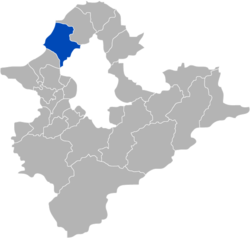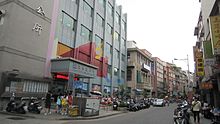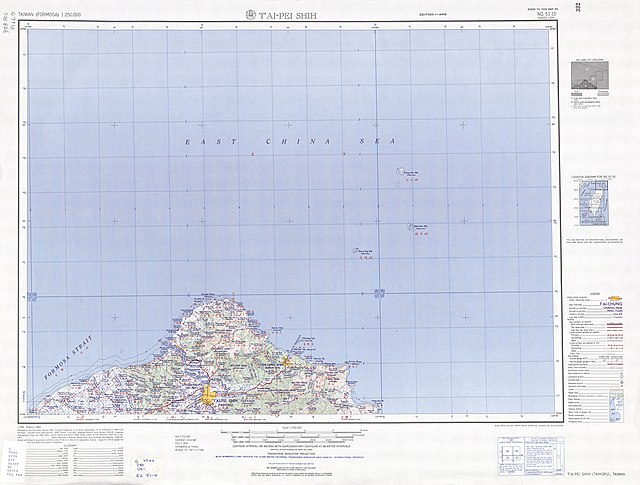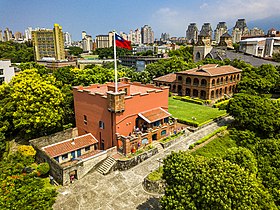Tamsui District
District in Taiwan From Wikipedia, the free encyclopedia
Tamsui District[1][2][3][4] (Chinese: 淡水; pinyin: Dànshuǐ; Pe̍h-ōe-jī: Tām-chúi; Tâi-lô: Tām-tsuí) is a seaside district in New Taipei City, Taiwan adjacent to the Tamsui River and overlooking the Taiwan Strait. The name of the district means "fresh water" in Chinese. Although modest in size (population 189,271), Tamsui plays a significant role in Taiwanese history and culture.
Tamsui, Taiwan
淡水區 Tansui, Danshuei, Tanshui, Danshui | |
|---|---|
 Tamsui District in New Taipei City | |
| Coordinates: 25°10′19″N 121°26′38″E | |
| Country | |
| Special municipality | New Taipei City, Taiwan |
| Area | |
| • Total | 70.65 km2 (27.28 sq mi) |
| Population (February 2023) | |
| • Total | 189,271 |
| • Density | 2,299/km2 (5,950/sq mi) |
| Time zone | +8 |
| Website | www |
| Tamsui | |||||||||||||||||||||||||||||||||||
|---|---|---|---|---|---|---|---|---|---|---|---|---|---|---|---|---|---|---|---|---|---|---|---|---|---|---|---|---|---|---|---|---|---|---|---|
 Tamsui District office | |||||||||||||||||||||||||||||||||||
| Chinese name | |||||||||||||||||||||||||||||||||||
| Chinese | 淡水 | ||||||||||||||||||||||||||||||||||
| Postal | Tamsui | ||||||||||||||||||||||||||||||||||
| |||||||||||||||||||||||||||||||||||
| Hobe | |||||||||||||||||||||||||||||||||||
| Traditional Chinese | 滬尾 | ||||||||||||||||||||||||||||||||||
| |||||||||||||||||||||||||||||||||||
| Japanese name | |||||||||||||||||||||||||||||||||||
| Kanji | 淡水 | ||||||||||||||||||||||||||||||||||
| Kana | たんすい | ||||||||||||||||||||||||||||||||||
| |||||||||||||||||||||||||||||||||||
Name
Historical
The Ketagalan aborigines called the location around modern Tamsui Hoba, meaning "stream's mouth." Hoba transliterated into Taiwanese Hokkien as Hobe. Historical works in English have referred to the place as "Hobe,"[5] "Hobé,"[6] or "Hobe Village."[7] 17th-century Spanish colonists labeled the region Casidor and the Tamsui River Kimalon. Dutch records reference the names Tamsuy and Tampsui but also refer to another "Lower Tamsuy" in southern Taiwan.[8]
Pastor George Leslie Mackay popularized "Tamsui" as the English-language transliteration in his 1895 book From Far Formosa.[9] "Tamsui" is consistent with Hokkien literary readings,[10][11] and (possibly by chance) is equal to the Church Romanization of an older pronunciation (Tām-súi) minus tone markings and hyphen.[12] By 1900, the "Tamsui" variant was already well-known[13] and featured prominently in two English-language maps of the area.[14] However, some naming confusion persisted, as evidenced by United States diplomat James W. Davidson's 1903 book The Island of Formosa. Davidson lists "Tamsui, Tamshuy, Tamshui, Tamsoui, [and] Tan-sui" as acceptable spellings and pronunciations.[6]
Historically, the term "Tamsui" is ambiguous, as "it may mean the harbor, the river, the village of Hobe, Twatutia, or Banka, and it may mean the whole district."[15]
Modern
From 1950 until the 2010 creation of New Taipei City, Tamsui was officially "Tamsui Township" (Chinese: 淡水鎮; Pe̍h-ōe-jī: Tām-chúi-tìn; Tâi-lô: Tām-tsuí-tìn) in the former Taipei County. The spelling "Danshui" (from Hànyǔ Pīnyīn Dànshuǐ), formerly used officially by the Taiwan government, Taipei Metro, and other sources, is based on the Mandarin pronunciation. Having long used "Tamsui" as the official English name,[citation needed] the local government of the district informed the national government in 2011 that "Tamsui" rather than "Danshui" should be used in English.
History
Spanish colony

The Spanish arrived in the area of Tamsui in the early 17th century. In the fall of 1629, the Spanish established the first major non-aboriginal settlement comprising the town and mission of Santo Domingo. The Spanish occupied northern Taiwan for the purpose of securing Spanish sea trade routes from coastal Fujian to Spanish Philippines against the Dutch (who were already established in the South of Taiwan by then), the British, and the Portuguese, as well as for facilitating trade with China and Japan.
In 1642, the Spanish were expelled from Taiwan by the Dutch. The Spanish had already abandoned their settlement in Tamsui in 1638 and the Dutch built a new fort over the ruins of Fort Santo Domingo which they renamed Fort Antonio (after the Governor-General of the Dutch East India Company Antonio van Diemen). It is today known as Angmng Siaⁿ (Chinese: 紅毛城; Pe̍h-ōe-jī: Âng-mn̂g-siâⁿ; lit. 'red-hair fortress') and is the main building of the Fort Santo Domingo museum complex. In addition to "pacifying" the aboriginal tribes in the area, the Dutch also encouraged the immigration and settlement of the area by Han Chinese, as well as expanding the production and trade of sulfur, animal skins, and other indigenous resources.
The Dutch left Fort Zeelandia in Taiwan in 1662 following their defeat by Koxinga at the Siege of Fort Zeelandia, who continued the policy of increasing Han Chinese immigration until the surrender of his grandson Zheng Keshuang to the Qing Dynasty in 1683. In 1668, the Dutch left Keelung after getting harassed by aboriginals from Tamsui.[16]
Qing dynasty

Because of its proximity to mainland China, as well as its location in a natural harbor, Tamsui quickly became a major fishing and trade port. The Qing naval patrol also established an outpost in Tamsui in 1808. In 1862, the Qing government opened Tamsui to foreign trade under the terms of the Treaty of Tientsin, exporting tea, camphor, sulfur, coal, opium, and dyes. By the mid-19th century Tamsui had become the largest port in Taiwan, boasting a sizable foreign population as well as a British consulate at Fort Santo Domingo.[17][18]

Canadian medical doctor and missionary George Leslie Mackay arrived in Tamsui on 9 March 1872, proceeding to establish Taiwan's first hospitals in Western medicine and formal educational facilities, including Oxford College (now part of Aletheia University), the oldest European-style higher-education institution in Taiwan by some measure.
During the Sino-French War the French attempted an invasion of Taiwan during the Keelung Campaign. Liu Mingchuan, who was leading the defence of Taiwan, recruited Aboriginals to serve alongside the Chinese soldiers in fighting against the French. The French were defeated at the Battle of Tamsui, and the Qing forces pinned the French down at Keelung in an eight-month-long campaign before the French withdrew.
In 1884, the harbour of Tamsui was blockaded by the French Navy under the command of Admiral Amédée Courbet, during the Sino-French War.[19] The French were defeated at the Battle of Tamsui by the Chinese and, according to traditional accounts, with the divine assistance of the Goddess Mazu.
Japanese rule


By the time Taiwan was ceded to Japan following the end of the Sino-Japanese War in 1895, Tamsui's position as a seaport was beginning to wane due to the accumulation of sediments in the Tamsui River. By the 20th century, most of Tamsui's port operations had moved to Keelung, and the local economy had switched primarily to agriculture. However, public infrastructure construction projects by the Japanese led to Tamsui's rise as a local administrative and cultural center.
In the early years of Japanese rule (1895–1945), the population of the city was nearly 6,000.[20] From 1920, under the prefecture system, Tamsui was called Tansui Town (淡水街), and was governed under Tansui District of Taihoku Prefecture.
Post-war

Following the end of World War II in 1945, Tamsui reverted to being a small fishing town as township of Taipei County. With the expansion of nearby Taipei City, Tamsui slowly became a center for tourism along Taiwan's northwest coast. In the last ten years, the city has become popular as a suburb of Taipei in the local real estate market.
Following the completion of the Taipei Metro's Tamsui Line in 1997, the town experienced a sharp increase in tourist traffic, reflected in the completion of several riverside parks, the growth of open-air markets specializing in traditional handicrafts and street-stall snacks, the construction of a fisherman's wharf, and the increase in passenger ferries traversing across and along the river.
Administrative divisions
Tamsui District administers forty-two urban villages (里).[21]
| Division | Chinese[21][22] | Romanization (from Tongyong Pinyin)[23][24] | Romanization (from Hanyu Pinyin)[25][24] | Romanization (from Wade–Giles) | Population (2010)[21] |
|---|---|---|---|---|---|
| Urban villages |
中和里 | Jhonghe[26] | Zhonghe[27] | Chung-ho[28] | 693 |
| 屯山里 | Tunshan | Tunshan | 1,229 | ||
| 賢孝里 | Siansiao | Xianxiao | Hsien-hsiao | 1,736 | |
| 興仁里 | Singren | Xingren | Hsing-jen | 1,749 | |
| 蕃薯里 | Fanshu | Fanshu | Fan-shu | 1,076 | |
| 義山里 | Yishan | Yishan | I-shan | 2,820 | |
| 忠山里 | Jhongshan | Zhongshan | Chung-shan | 1,026 | |
| 崁頂里 | Kanding | Kanding | K’an-ting | 2,632 | |
| 埤島里 | Pidao | Pidao | P’i-tao | 1,312 | |
| 新興里 | Sinsing | Xinxing | Hsin-hsing | 6,547 | |
| 水碓里 | Shueiduei[29] | Shuidui | Shui-tui | 6,304 | |
| 北投里 | Beitou | Beitou | Pei-t’ou | 5,779 | |
| 水源里 | Shueiyuan | Shuiyuan | Shui-yüan | 2,516 | |
| 忠寮里 | Jhongliao | Zhongliao | Chung-liao | 1,354 | |
| 樹興里 | Shusing | Shuxing | Shu-hsing | 1,165 | |
| 坪頂里 | Pingding | Pingding | P’ing-ting | 1,411 | |
| 福德里 | Fude | Fude | Fu-te | 6,574 | |
| 竹圍里 | Jhuwei | Zhuwei | Chu-wei | 6,322 | |
| 民生里 | Minsheng | Minsheng | Min-sheng | 6,774 | |
| 八勢里 | Bashih | Bashi | Pa-shih | 4,374 | |
| 竿蓁里 | Ganjhen | Ganzhen | Kan-chen | 7,890 | |
| 鄧公里 | Denggong | Denggong | 6,355 | ||
| 中興里 | Jhongsing | Zhongxing | Chung-hsing | 4,613 | |
| 長庚里 | Changgeng | Changgeng | 1,686 | ||
| 清文里 | Cingwun | Qingwen | 1,320 | ||
| 草東里 | Caodong | Caodong | 901 | ||
| 協元里 | Sieyuan | Xieyuan | 1,749 | ||
| 永吉里 | Yongji | Yongji | 1,018 | ||
| 民安里 | Min-an | Minan/Min'an | 930 | ||
| 新生里 | Sinsheng | Xinsheng | Hsin-sheng | 999 | |
| 文化里 | Wunhua | Wenhua | 2,133 | ||
| 油車里 | Youche | Youche | Yu-ch’e | 5,628 | |
| 沙崙里 | Shalun | Shalun | Sha-lun | 3,499 | |
| 新義里 | Sinyi | Xinyi | Hsin-i | 4,658 | |
| 新春里 | Sinchun | Xinchun | 6,870 | ||
| 新民里 | Sinmin | Xinmen | Hsin-min | 4,960 | |
| 正德里 | Jhengde | Zhengde | Cheng-te | 4,482 | |
| 北新里 | Beisin | Beixin | Pei-hsin | 2,907 | |
| 民權里 | Mincyuan | Minquan | Min-ch’uan/Min-ch’üan | 3,940 | |
| 幸福里 | Singfu | Xingfu | Hsing-fu | 4,742 | |
| 學府里 | Syuefu | Xuefu | 4,357 | ||
| 大庄里 | Dajhuang | Dazhuang | 4,451 |
Climate
| Climate data for Tamsui District (1991–2020 normals, extremes 1942–present) | |||||||||||||
|---|---|---|---|---|---|---|---|---|---|---|---|---|---|
| Month | Jan | Feb | Mar | Apr | May | Jun | Jul | Aug | Sep | Oct | Nov | Dec | Year |
| Record high °C (°F) | 28.4 (83.1) |
29.0 (84.2) |
31.9 (89.4) |
33.6 (92.5) |
35.8 (96.4) |
37.3 (99.1) |
38.8 (101.8) |
38.5 (101.3) |
37.4 (99.3) |
35.8 (96.4) |
32.8 (91.0) |
30.5 (86.9) |
38.8 (101.8) |
| Mean daily maximum °C (°F) | 18.8 (65.8) |
19.3 (66.7) |
21.6 (70.9) |
25.4 (77.7) |
28.8 (83.8) |
31.3 (88.3) |
33.3 (91.9) |
33.1 (91.6) |
30.9 (87.6) |
27.1 (80.8) |
24.4 (75.9) |
20.6 (69.1) |
26.2 (79.2) |
| Daily mean °C (°F) | 15.4 (59.7) |
15.7 (60.3) |
17.7 (63.9) |
21.4 (70.5) |
24.7 (76.5) |
27.3 (81.1) |
29.0 (84.2) |
28.7 (83.7) |
26.9 (80.4) |
23.6 (74.5) |
21.0 (69.8) |
17.3 (63.1) |
22.4 (72.3) |
| Mean daily minimum °C (°F) | 12.7 (54.9) |
13.0 (55.4) |
14.7 (58.5) |
18.3 (64.9) |
21.6 (70.9) |
24.2 (75.6) |
25.7 (78.3) |
25.5 (77.9) |
23.8 (74.8) |
20.9 (69.6) |
18.3 (64.9) |
14.6 (58.3) |
19.4 (66.9) |
| Record low °C (°F) | 2.3 (36.1) |
3.2 (37.8) |
3.1 (37.6) |
6.7 (44.1) |
13.4 (56.1) |
15.4 (59.7) |
20.4 (68.7) |
19.6 (67.3) |
15.5 (59.9) |
10.6 (51.1) |
7.6 (45.7) |
4.2 (39.6) |
2.3 (36.1) |
| Average precipitation mm (inches) | 105.9 (4.17) |
148.0 (5.83) |
153.4 (6.04) |
157.6 (6.20) |
239.8 (9.44) |
257.4 (10.13) |
119.8 (4.72) |
218.3 (8.59) |
290.1 (11.42) |
165.8 (6.53) |
104.2 (4.10) |
112.4 (4.43) |
2,072.7 (81.6) |
| Average precipitation days (≥ 0.1 mm) | 13.9 | 13.8 | 15.2 | 13.6 | 12.6 | 12.2 | 8.3 | 10.9 | 11.8 | 12.3 | 12.4 | 12.5 | 149.5 |
| Average relative humidity (%) | 80.8 | 82.4 | 81.0 | 79.9 | 79.2 | 79.9 | 75.0 | 76.0 | 76.1 | 77.8 | 78.5 | 79.0 | 78.8 |
| Mean monthly sunshine hours | 83.1 | 80.4 | 92.7 | 105.9 | 135.6 | 155.9 | 226.9 | 208.6 | 171.7 | 127.5 | 101.9 | 84.1 | 1,574.3 |
| Source: Central Weather Bureau[30][31][32][33][34] | |||||||||||||
Education
Tourist attractions


- Drop of Water Memorial Hall
- Former British Merchant Warehouse
- Fort Santo Domingo
- Hobe Fort
- Museum of Tamsui Fishiegoodies
- Tamsui Art Gallery
- Tamsui Church
- Tamsui Customs Officers' Residence
- Tamsui Customs Wharf
- Tamsui Fisherman's Wharf
- Tamsui Fuyou Temple
- Tamsui Historical Museum
- Tamsui Lover's Bridge
- Tamsui Lovers' Tower
- Tamsui Lungshan Temple
- Tamsui Meteorological Observatory
- Tamsui Old Street
- Tamsui Qingshui Temple
- Tamsui Qingshui Deity's Grand Procession, on 6th day of 5th lunar month, an important fiesta for Tamsui District
- Tamsui Red Castle
- Teng Feng Fish Ball Museum
Transportation

Taipei Metro
Light rail
Sister city
Notable natives
- Joe Hung, representative to Italy (1993–2000)
- Tu Tsung-ming, former physician
Gallery
- A French sketch of Tamsui in 1893
- Tamsui Port, circa 1970
- The Yinshan Temple in Tamsui, 2018
- Tamsui Harbor (Li Mei-shu, 1930)
- Tamsui (Tan Ting-pho, 1935) – 91 × 116.5 cm – Taiwan Museum of Fine Arts
- Tamsui Church (Ni Chiang-huai, 1936) – Paper, watercolor – 49.5 × 66 cm – Taipei Museum of Fine Arts
- Tamsui waterfront at sunset
- The sunset in front of the Long Pier of Tamsui
Sources
- History section retrieved and translated from Tamsui District office website.
Notes
Bibliography
External links
Wikiwand in your browser!
Seamless Wikipedia browsing. On steroids.
Every time you click a link to Wikipedia, Wiktionary or Wikiquote in your browser's search results, it will show the modern Wikiwand interface.
Wikiwand extension is a five stars, simple, with minimum permission required to keep your browsing private, safe and transparent.















